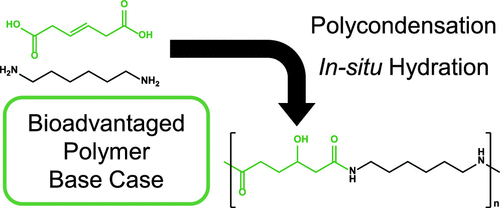当前位置:
X-MOL 学术
›
Macromolecules
›
论文详情
Our official English website, www.x-mol.net, welcomes your feedback! (Note: you will need to create a separate account there.)
Analysis of the Amorphous and Interphase Influence of Comononomer Loading on Polymer Properties toward Forwarding Bioadvantaged Copolyamides
Macromolecules ( IF 5.5 ) Pub Date : 2021-08-17 , DOI: 10.1021/acs.macromol.1c00651 Sanaz Abdolmohammadi 1, 2 , Dustin Gansebom 1, 2 , Shailja Goyal 1 , Ting-Han Lee 1 , Baker Kuehl 1 , Michael J. Forrester 1 , Fang-Yi Lin 1 , Nacú Hernández 1 , Brent H. Shanks 1, 2 , Jean-Philippe Tessonnier 1, 2 , Eric W. Cochran 1
Macromolecules ( IF 5.5 ) Pub Date : 2021-08-17 , DOI: 10.1021/acs.macromol.1c00651 Sanaz Abdolmohammadi 1, 2 , Dustin Gansebom 1, 2 , Shailja Goyal 1 , Ting-Han Lee 1 , Baker Kuehl 1 , Michael J. Forrester 1 , Fang-Yi Lin 1 , Nacú Hernández 1 , Brent H. Shanks 1, 2 , Jean-Philippe Tessonnier 1, 2 , Eric W. Cochran 1
Affiliation

|
Here we present an approach for selectively modifying the properties of semicrystalline polymers by introducing ″bioadvantaged″ counits. With this approach, the unique functionality of biomass can be leveraged to tailor the properties of the amorphous phase of semicrystalline polymers with minimal impact on crystallinity and thermomechanical properties. As a model case, PA 6,6 copolyamides were produced using the bioadvantaged monomer trans-3-hexenedioic acid (t3HDA). The analogous structure of t3HDA to adipic acid, a PA 6,6 monomer, allows for a seamless integration. Screening over the entire composition range identified the t3HDA loading (20 mol %) beyond which properties deviate appreciably from Nylon 6,6. Once identified, copolyamides of suitable compositions were upgraded to commercial quality and fully characterized to assess the influence of counit loading and polymer structure on thermal and mechanical properties. Samples were characterized using gel permeation chromatography (GPC), proton nuclear magnetic resonance spectroscopy (1H NMR), heteronuclear single quantum coherence spectroscopy (HSQC), wide-angle X-ray scattering (WAXS), differential scanning calorimetry (DSC), thermogravimetric analysis (TGA), dynamic mechanical analysis (DMA), tensile testing, flexural testing, and water absorption testing. t3HDA units were shown to hydrate during the harsh polycondensation to 3-hydroxyhexanedioic acid (3HHDA) and fully incorporate into the polymer backbone. Loading levels up to 20% were shown to have comparable thermal and mechanical properties in the dry state, yet moisture absorption—a known method for improving the toughness, yield strain, and elongation of polyamides—was enhanced by over 100% at 20% loading. This case study on bioadvantaged copolymers elucidates the governing structure–function principles that can be leveraged to forward value-added renewable polymers.
中文翻译:

共聚单体负载对聚合物性能的无定形和界面影响分析,以促进生物优势共聚酰胺的发展
在这里,我们提出了一种通过引入“生物优势”单元来选择性地改变半结晶聚合物性质的方法。通过这种方法,可以利用生物质的独特功能来调整半结晶聚合物的无定形相的特性,同时对结晶度和热机械特性的影响最小。作为模型案例,PA 6,6 共聚酰胺是使用生物优势单体反式-3-己烯二酸 ( t 3HDA) 生产的。t 3HDA 与己二酸(一种 PA 6,6 单体)的类似结构允许无缝集成。对整个成分范围进行筛选确定了t3HDA 负载量 (20 mol %) 超过该负载量,性能与尼龙 6,6 明显不同。一旦确定,合适组成的共聚酰胺将升级为商业质量并充分表征以评估共聚负载和聚合物结构对热和机械性能的影响。使用凝胶渗透色谱 (GPC)、质子核磁共振光谱 ( 1 H NMR)、异核单量子相干光谱 (HSQC)、广角 X 射线散射 (WAXS)、差示扫描量热法 (DSC)、热重法对样品进行表征分析 (TGA)、动态力学分析 (DMA)、拉伸测试、弯曲测试和吸水率测试。吨3HDA 单元在剧烈缩聚成 3-羟基己二酸 (3HHDA) 期间会发生水合,并完全结合到聚合物主链中。在干燥状态下,高达 20% 的负载水平显示出具有可比性的热和机械性能,但吸湿性(一种已知的用于改善聚酰胺的韧性、屈服应变和伸长率的方法)在 20% 的负载下提高了 100% 以上. 这个关于生物优势共聚物的案例研究阐明了可用于推进增值可再生聚合物的控制结构 - 功能原理。
更新日期:2021-09-14
中文翻译:

共聚单体负载对聚合物性能的无定形和界面影响分析,以促进生物优势共聚酰胺的发展
在这里,我们提出了一种通过引入“生物优势”单元来选择性地改变半结晶聚合物性质的方法。通过这种方法,可以利用生物质的独特功能来调整半结晶聚合物的无定形相的特性,同时对结晶度和热机械特性的影响最小。作为模型案例,PA 6,6 共聚酰胺是使用生物优势单体反式-3-己烯二酸 ( t 3HDA) 生产的。t 3HDA 与己二酸(一种 PA 6,6 单体)的类似结构允许无缝集成。对整个成分范围进行筛选确定了t3HDA 负载量 (20 mol %) 超过该负载量,性能与尼龙 6,6 明显不同。一旦确定,合适组成的共聚酰胺将升级为商业质量并充分表征以评估共聚负载和聚合物结构对热和机械性能的影响。使用凝胶渗透色谱 (GPC)、质子核磁共振光谱 ( 1 H NMR)、异核单量子相干光谱 (HSQC)、广角 X 射线散射 (WAXS)、差示扫描量热法 (DSC)、热重法对样品进行表征分析 (TGA)、动态力学分析 (DMA)、拉伸测试、弯曲测试和吸水率测试。吨3HDA 单元在剧烈缩聚成 3-羟基己二酸 (3HHDA) 期间会发生水合,并完全结合到聚合物主链中。在干燥状态下,高达 20% 的负载水平显示出具有可比性的热和机械性能,但吸湿性(一种已知的用于改善聚酰胺的韧性、屈服应变和伸长率的方法)在 20% 的负载下提高了 100% 以上. 这个关于生物优势共聚物的案例研究阐明了可用于推进增值可再生聚合物的控制结构 - 功能原理。



























 京公网安备 11010802027423号
京公网安备 11010802027423号